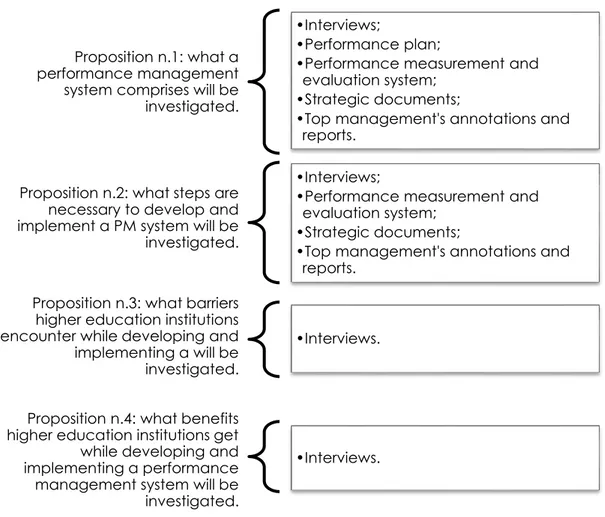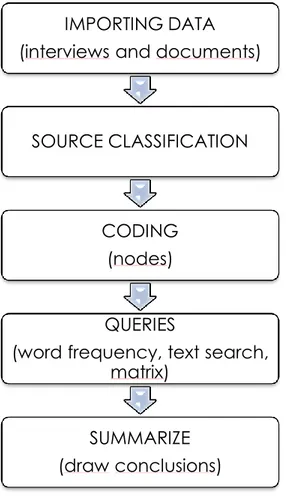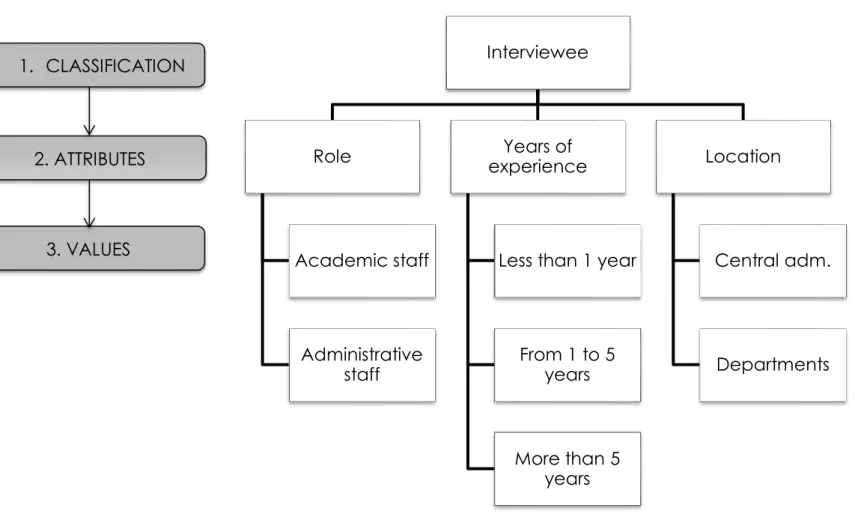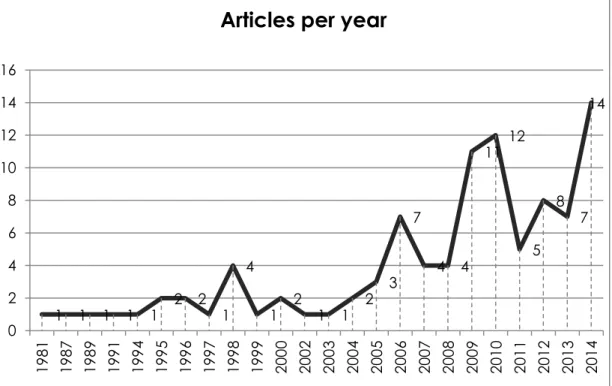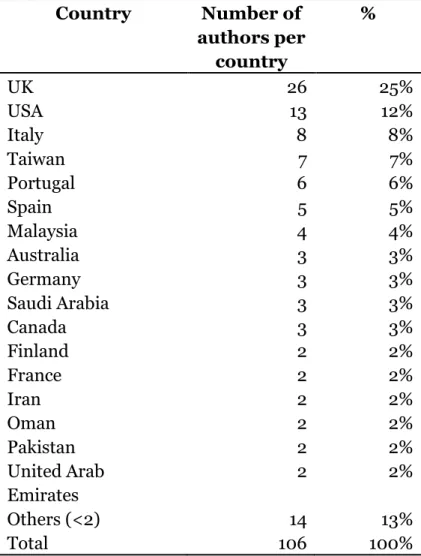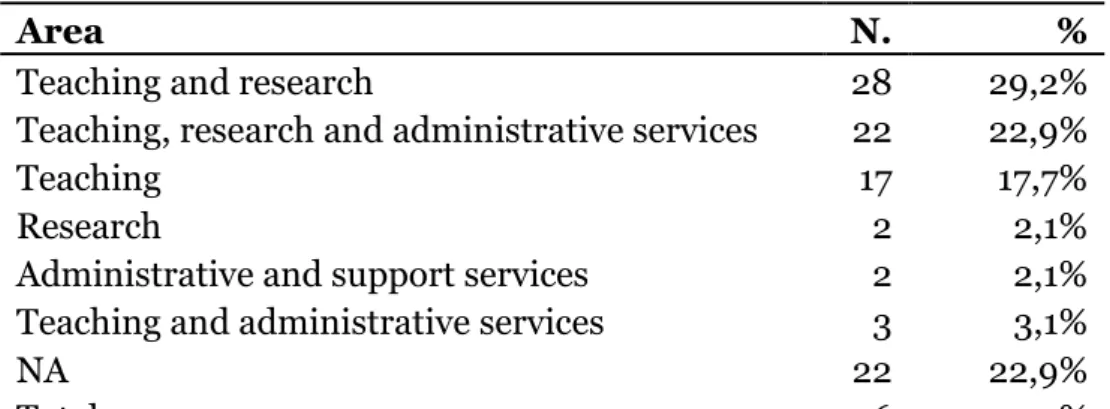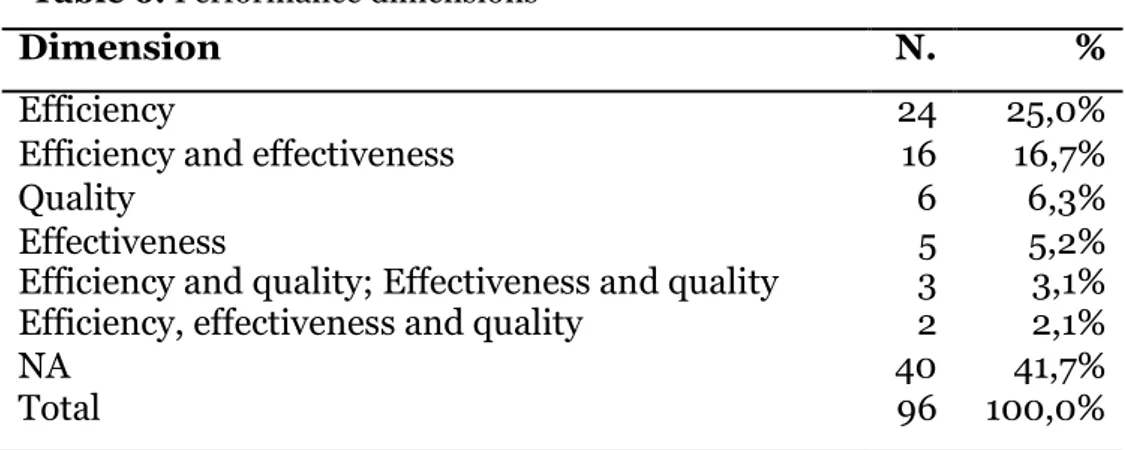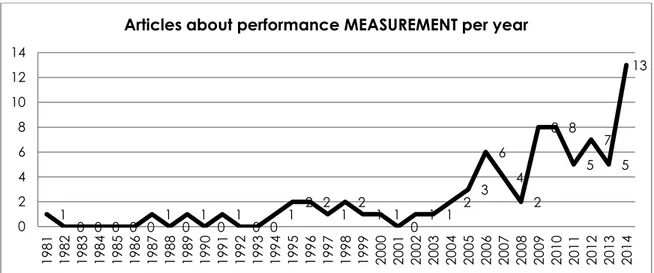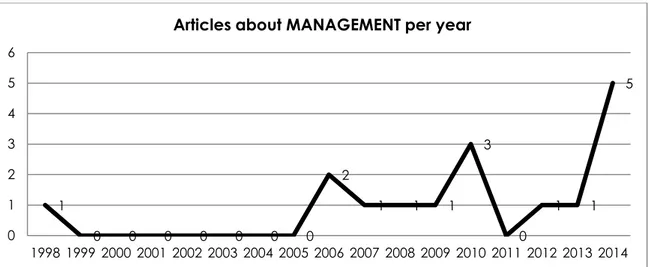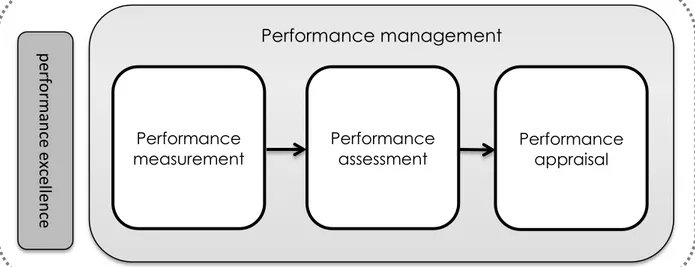UNIVERSITÀ DEGLI STUDI DELLA TUSCIA DI VITERBO
DIPARTIMENTO DI ECONOMIA E IMPRESACorso di Dottorato di Ricerca in Economia e territorio - XXVI Ciclo
PERFORMANCE MANAGEMENT IN HIGHER EDUCATION:
THEORETICAL FOUNDATIONS AND EMPIRICAL INVESTIGATIONS(S.S.D. SECS-P/13)
Tesi di dottorato di: Dott. Elsa Serpico
Coordinatore del corso Tutore
Prof. Alessandro Sorrentino Prof. Alessandro Ruggieri
Data della discussione 24 giugno 2015
TABLE OF CONTENTS
PART I - INTRODUCTION AND RESEARCH DESIGN1.1. Background ... 4
1.2. Purpose of the study and research question ... 5
1.3. Performance in the industry of higher education ... 7
1.4. Research design ... 9
1.4.1. Definition of research question ... 9
1.4.2. Performance management system in previous research ... 10
1.4.3. Performance management system in the case study ... 10
1.4.3.1. Data collection ... 11
1.4.3.2. Qualitative data analysis ... 12
PART II - LITERATURE REVIEW ON PERFORMANCE MANAGEMENT IN HIGHER EDUCATION 2.1. Introduction ... 18
2.2. Literature review methodology ...19
2.3. Literature review findings ... 21
2.4. Main concepts and approaches ... 25
2.4.1. Performance measurement ... 32 2.4.2. Performance assessment ... 33 2.4.3. Performance appraisal ... 35 2.4.4. Performance management ... 36 2.4.5. Performance excellence... 40 2.4.6. Antecedents of performance ... 41
2.5. Literature review framework ... 43
2.6. Literature gaps ... 45
2.7. Performance management systems in higher education: evidence from the literature review ... 46
2
2.7.1. Introduction ... 46
2.7.2. Performance Management System Composition ... 47
2.7.3. Development and implementation steps ... 57
PART III - EMPIRICAL FINDINGS 3.1. The Italian higher education system ... 60
3.1.2. Self-assessment, periodic assessment and accreditation system of higher education ... 61
3.1.3. The reform of the Italian public administration ... 64
3.2. The experience at the University of Tuscia ... 67
3.2.1. Introduction ... 67
3.2.2. Data collection ... 67
3.2.2.1. Semi-structured interviews ... 67
3.2.2.2. Documentary analysis ... 69
3.3. Performance management system composition ... 70
3.4. Designing and implementing a performance management system ... 76
3.5. Barriers in developing and implementing a performance management system ... 78
3.6. Benefits in implementing a performance management system ... 82
PART IV – DISCUSSION AND CONCLUSIONS 4.1. Answering the research question ... 85
4.2. Contribution ... 87
4.3. Future research directions ... 87
4.4. Managerial implications ... 88
4.5. Limitations ... 88
REFERENCES ... 90
List of figures ... 101
3 APPENDICES ... 103 APPENDIX A ... 104 APPENDIX B ... 111 APPENDIX C ... 113 AKNOWELDGEMENT ... 114
4
Part I - Introduction and Research design
1.1. Background
Over the last 30 years, there have been noticeable changes in higher education sector and institutions have transformed towards an economic sector similar to manufacturing industry (Gumport, 2000). At the beginning of the 80s, higher education was described as an organization operating in a non-competitive market and with limited managerial discretion (Lindsay, 1981). From that moment on, a reforming trend moved higher education from a centralized system to a more competitive one. The main assumption is that competition increases performance since it requires higher education institutions to be more flexible, to improve their efficiency and to increase customer satisfaction (e.g., Agasisti, 2009; Allen & Shen, 1999; Dill, 2003; Feller, 1996)
According to Cosenz (2011) the higher education sector has witnessed: 1. Resource constraints and budget reductions;
2. “Marketization” of higher education sector (e.g., Mok & Lo, 2002; Williams, 1997);
3. Accountability: institutions are pressed by governments to become more accountable in the use of resources.
Moreover, enrollment growth in higher education reveals a shift from elite to mass, defined “massification” of higher education (Alexander, 2000). The increase in competition in higher education sector was due to the scarcity of resources and erosion of trust from governments who began to ask institutions to demonstrate their good performance.
In brief, factors like “massification” of higher education, cuts in public funding, greater competition and marketization of higher education sector and diversification forced higher education institutions to evolve and to apply performance management approaches. It is the nature of the above mentioned changes in the higher education sector that provides the impetus for this research.
5
1.2. Purpose of the study and research question
Performance management has become an important topic for all organizations, even for higher education institutions. Pressures for efficiency, accountability, enhanced quality and for a market-driven commercial enterprise model have been leading higher education institutions to emphasize the management of performance rather than the management for performance (Lonsdale, 1998). Thus, since the last decades higher education institutions have begun to adopt performance management systems imported from other businesses, even though they have been criticized for not being suitable within higher education context. The growing interest for performance management in higher education has not yet generated an in-depth analysis from researchers. To be more precise, scholars have not fully studied this topic but there has been an increasing focus in both the academic literature and practice on measuring performance in higher education. Nonetheless, little attention has been paid to the management of performance and this research is a contribute forward this direction.
For the above mentioned reasons, the main research question is the following:
RQ: How can higher education institutions develop and implement performance management systems?
In order to explore this topic, the research question was divided into four propositions.
A performance management system is shaped according to the context and to the specific peculiarities of the organization. For this reason, one of the first investigation concerned the composition and configuration of performance management systems in higher education institutions, especially their subsystems and the interaction among them.
Proposition n.1: what a performance management system comprises will be investigated.
A secondary step was trying to identify what steps are appropriate for both developing and implementing a performance management system.
Proposition n.2: what steps need to be taken to develop and implement a performance management system will be investigated.
In studying ‘how’ to implement and develop a performance management system, it could turn out to be useful to discover and anticipate what barriers institutions could meet and what benefits could arise.
Proposition n.3: what barriers higher education institutions encounter while developing and implementing a performance management system will be investigated.
6
Proposition n.4: what benefits higher education institutions get while developing and implementing a performance management system will be investigated.
Thence, to answer the research question this Ph.D. Dissertation tracked all four propositions by surveying the application of performance management systems in higher education through a literature review and then by studying the case of an Italian university in depth. Particularly, this case study reports the experience of a higher education institution in developing and implementing an integrated performance management system. The various stages are described and characteristics of the final system discussed.
The aim of this study is therefore twofold, to give some evidence on how a performance management system can be implemented in a higher education institution; and to provide some insights about the barriers and potential benefits.
7
1.3. Performance in the industry of higher education
A clear and universal definition of performance does not exist, the complexity of the concept requires a multidimensional prospective, including both financial and not financial aspects and both quantitative and qualitative data (Cosenz, 2011; Kaplan & Norton, 1996).
The general concept of performance raised in Anglo-Saxon countries and was originally defined as the results that a firm achieves in a specific period of time. In particular, the first definition of performance in higher education appeared at the beginning of the 80’s (Lindsay, 1981). This first notion of performance comprised two main concepts: efficiency and effectiveness. Hence, assessing institutional performance meant to investigate how effective the institution is achieving its goals and how efficiently it uses its resources. A similar definition was provided by Ball and Halwachi (1987) who distinguished performance into effectiveness –that is, how effectively the intuition meets the needs of society – and efficiency – that is, how well the institution is functioning internally.
Cosenz (2011) stated that performance of universities is the contribution of a set of actions undertaken in order to create social, economic and competitive value. Thus, Cosenz’s (2011) point of view was similar to Armstrong (2006), who stated that academic performance is not only a matter of if a result has been achieved, but also how it has been achieved, hence to understand what performance means we need to focus on inputs, outputs and processes. Moreover, in higher education institutions performance must be observed discerning among performance of teaching, research and other services since each activity implies the attainment of different results, for example teaching aims at educating individuals for professional purposes, research aims at developing scientific knowledge, support and administrative services help academic staff in teaching and research activities, etc. Yu, Hamid, Ijab, and Soo (2009) stated: it is noteworthy to remember that
performance should not be about producing reports. Instead it should be about the decision made or direction taken with the available information of the current situation.
As shown in Table 1, the literature has not examined in depth the concept of performance in higher education and to date there is not a shared definition. For this reason, this study offers its own definition of performance in the context of higher education.
In general, performance in the industry of higher education is the results achieved
by an institution in meeting the intended purposes - declared in strategic planning documents – in teaching, research, administrative and support services.
8 Table 1. Definitions of Performance in higher education
Definition Source
The use of the term "performance" invokes the notions of "accomplishment," "attainment," and "the execution of a task". Hence, assessing an institution's performance involves asking how well the institution is carrying out its functions. In other words, how effective is the institution in attaining its goals and how efficiently does it use its resources in the process.
Lindsay (1981)
A statement, usually quantified, on resources employed and achievements secured in areas relevant to the particular objectives of the enterprise.
They must:
Relate to objective
Be specific, quantifiable and standardized
Be as simple as possible
Be acceptable and credible
Be capable of acting as signposts to area needing attention
Jarratt (1985) cited by Higgins (1989)
(…) how effectively the intuition meets the needs of society and how well the institution is functioning internally.
Ball and Halwachi (1987)
9
1.4. Research design
1.4.1. Definition of research question
Over the past three decades, the industry of higher education underwent the following major changes:
Resource constraints and budget reductions;
Public higher education institutions have been pressed by governments to become more accountable in the use of resources (accountability);
“Marketization” of higher education sector;
Reforming trend which moved higher education from a centralized system to a more competitive one;
Enrollment growth has revealed a shift from elite to mass, defined “massification” of Higher Education.
In order to survive, higher education institutions have been hence obliged to adapt, their first reactions to these transformations lied in the desire to observe and emulate the way other organizations succeeded in managing performance. Nevertheless, scholars have been studying this topic for just a few years and this motivated the willing to study higher education institutions have dealt with performance management so far, and understand the most suitable practices and approaches.
RQ: How can higher education institutions develop and implement performance management systems?
The research question was then divided in the following theoretical propositions, which also correspond to the research objectives:
1. Gaining an understanding of what a performance management system comprises;
2. Gaining an understanding of what steps are necessary to develop and implement a PM system;
3. Gaining an understanding of what barriers higher education institutions encounter while developing and implementing a performance management system;
4. Gaining an understanding of what benefits higher education institutions get while developing and implementing a performance management system. The research question also dictated the methodology and approach selected. Considering the originality of this research and the gaps in literature, an
exploratory research was conducted. This type of scientific research is conducted
when the research goals are:
10
2. To provide some initial insights on a phenomenon;
3. To evaluate the feasibility of a research project (Bhattachejee, 2012).
In brief, to answer the research question, the Ph.D. Dissertation was fundamentally divided into two main parts:
Conduction of a comprehensive literature review about the application of performance management systems in higher education institutions;
Examination of an empirical case study in depth, involving a higher education institution that developed and implemented a performance management system.
The unit of analysis of this research could have been at individual or at departmental or at institutional level. For the aims of this research, the research question has focused on higher education institutions, that can be defined as
multiproduct and multiproduct organizations that operate in diversified and integrated fields whose common denominator is knowledge management
(Paletta, 2004).
1.4.2. Performance management system in previous research
After developing the research question, a systematic literature review was conducted aiming at investigating how other scholars had approached to this argument and at discovering if some evidences exist.
The literature review was carried out using the systematic methodology (Tranfield, Denyer, & Smart, 2003) and the concept-centric approach (Webster & Watson, 2002), its findings were handled for two main purposes:
To overview the state of the art in the academic literature and identify literature gaps or shortcomings (Sections 2.4, 2.5, 2.6);
To track each theoretical proposition, that is to investigate if and how past research studied the performance management systems in higher education (Section 2.7).
The focus was especially set on empirical papers, which were carefully read, then analyzed in depth and interpreted as most objectively as possible.
1.4.3. Performance management system in the case study
The empirical part of the Ph.D. Dissertation (part III) shows an exploratory case study that involved an Italian higher education institution (University of Tuscia). According to Yin (1994), case studies are the preferred research method when the
11
investigator has the desire to understand a real life phenomenon in depth, such as organizational and managerial processes, and in particular:
“when ‘how’ or ‘why’ questions are being posed, when the investigator has little control over events, and when the focus is on a contemporary phenomenon within some real-life context.”
Furthermore, the variables of interest are more numerous than data points and the complexity of the phenomenon would need multiple sources of evidence. However, the case study approach has been often accused not to be reliable, objective and not to legitimate research strategy. It is arguable of a case study findings can be generalized to a larger population, but it is surely valid and reliable to generalize findings to the theoretical propositions, especially when the case study research follows a rigorous and systematic procedure (Yin, 1994, 2011).
The case study has been presented and discussed in order to provide information in relation to the following research question:
RQ: How did the University of Tuscia develop and implement a performance management system?
1.4.3.1. Data collection
Empirical data were gathered from two main sources: 1) Primary data, obtained from interviews;
2) Secondary data, obtained from documentation.
Interviews were combined with documentation, in order to investigate the research question. According to Yin (1994, 2011), collected data should be linked to propositions, as shown in Figure 1.
As regards primary data, the research needed an elaborated ‘in-depth’ response, hence a semi-structured interview was chosen (Gillham, 2000, 2005). Semi-structured interviews are more flexible and allow much more leeway to researcher, they comprise both open and closed questions.
Below, the individual stages to conduct the interviews are listed: 1. Development of the interview, i.e. questions and prompts;
2. Selection of participants, i.e. both academic and administrative staff; 3. Submission of a proposal and first contact with the potential interviewees; 4. Conduction of the interview:
4.1. Introduction, i.e. the interviewer explains the purpose of the interview and of the research, the probable length of the interview and why he would like to record it;
12
4.3. Closure.
To respect the privacy of respondents, every interview has been coded (Table 2). In this way, it is possible to know the position of the interviewee but not his/her identity.
As regards secondary data, the documentation of the University of Tuscia was taken from the website and from the CEO’s personal archive (e.g., letters and annotations). Details about the collected documentation are reported in Section 3.2.2.
Figure 1. Link between propositions and collected data
1.4.3.2. Qualitative data analysis
Before analyzing data, the interviews were transcribed and coded (see Table 2). The codification was needed to protect the privacy of respondents, without losing information about their position and functions at the University of Tuscia.
Proposition n.1: what a performance management system comprises will be investigated.
•Interviews;
•Performance plan;
•Performance measurement and evaluation system;
•Strategic documents;
•Top management's annotations and reports.
Proposition n.2: what steps are necessary to develop and implement a PM system will be investigated.
•Interviews;
•Performance measurement and evaluation system;
•Strategic documents;
•Top management's annotations and reports.
Proposition n.3: what barriers higher education institutions encounter while developing and implementing a will be investigated.
•Interviews.
Proposition n.4: what benefits higher education institutions get while developing and implementing a performance management system will be investigated.
13 Table 2. Codification of interviews
Participant position Codes
Top management TMA1, TMA2, TMA3
Vice-managers VMA
President of the Independent Evaluation
Committee PIEC
President of the Quality Presidium PQP President of the Technical Standing
Committee PTSC
Administrative staff ADM1, ADM2, ADM3, ADM4,
ADM5, ADM6
Academic staff ACA1, ACA2, ACA3, ACA4,
ACA5, ACA6
Student Representatives STUD
Member of the Board of Directors of ANVUR
ANV
The documentation was selected on the basis of the following criteria:
Public documents were downloaded from the institutional website, in the
subsection of “Transparent Administration”
(http://www3.unitus.it/index.php?option=com_content&view=article&id= 1386&Itemid=772&lang=it);
Documents had to be published in electronic format during 2010-2015, since the first official evidence of a clear involvement in performance management goes back to 2010, when the University decided to apply the Common Assessment Framework;
Not official documents, such as letters and annotations, were considered only if written by the top management (i.e. the Rector, the Chief Executive Officer and Managers);
If document were drafted annually, the latest version was taken into account.
In order to corroborate findings and test construct validity, the case study used multiple sources of evidence - interviews, public records, private records, administrators’ personal files - all triangulating on the same research question (Walsham, 1995, 2006). The application of multiple methods to examine the same research problem was a useful technique for cross-validating data and is known as
14
NVivo software was used for the analysis of both interviews and documents, especially to simplify and facilitate the management of records and ideas. The process carried out for this analysis is illustrated in Figure 2.
Figure 2. Qualitative data analysis flow-chart through NVivo
All documents and interviews were imported and classified on the basis of some attributes, as illustrated in Figure 3 and 4. Interviews were classified according to:
Role: assuming that academic and administrative staff could have different views about the performance management system;
Years of experience: in the development and/or implementation of performance management system at the University of Tuscia;
Location: assuming that the level of knowledge could change if the respondent worked at the central administration or at the department. The documents were classified according to the following attributes:
IMPORTING DATA (interviews and documents)
SOURCE CLASSIFICATION
CODING (nodes) QUERIES
(word frequency, text search, matrix)
SUMMARIZE (draw conclusions)
15 Source: written by the governance (Rector, CEO, Board of Directors, Senate), by the top management (Vice-managers and managers) or by staff (academic or administrative);
Target: addressed to internal or external stakeholders;
Year of publication: from 2010 to 2015;
Area: related to teaching, research, support services or a combination of them.
Codification of data with NVivo was propositions-driven, hence four “nodes” were used, each of them corresponding to a research proposition:
Node 1: Composition of the system
Node 2: Steps
Node 3: Barriers
Node 4: Benefits
In order to find some information useful to answer my research question, text-mining queries were finally used, i.e. word frequency and text search.
Figure 3. Source classification of interviews through NVivo Interviewee Role Academic staff Administrative staff Years of experience
Less than 1 year
From 1 to 5 years More than 5 years Location Central adm. Departments 1. CLASSIFICATION 2. ATTRIBUTES 3. VALUES
17 Figure 4. Source classification of documents through NVivo
Documents Source Governance Management Staff Target Internal stakeholders External stakeholders Year of pubblication 2010 ... 2015 Area Research Teaching Services 1. CLASSIFICATION 2. ATTRIBUTES 3. VALUES
Part II - Literature Review on Performance
Management in Higher Education
2.1. Introduction
This Ph.D. Dissertation aims at understanding how to develop and implement a performance management system, thus the literature review will try to identify which approaches have been used by scholars to study performance management in higher education.
In the management literature, reviews have been often criticized because of their subjectivity, for this reason a systematic search was carried out, providing a transparent and reproducible process of examination and improving the quality of the literature analysis. The systematic literature search considered peer reviewed papers, written in English and published on international journals. The most relevant result of this review was the identification and description of six main concepts (Section 2.4) that were synthetized in a conceptual framework (Section 2.5). Furthermore, several gaps in knowledge were identified that delineate future research directions. Finally, the literature review findings were useful to investigate the research question, that is to find out how performance management systems have been developed and implemented, their configuration, the possible barriers and potential benefits.
19
2.2. Literature review methodology
The literature search is based on the systematic methodology (Tranfield et
al., 2003) and on the concept-centric approach (Webster & Watson, 2002).
For this literature search, two scientific databases have been used: ISI web of Science and Scopus. The process undertaken for this research is described by the following chronological steps:
1. Definition of the topic and identification of keywords. The chosen keywords were “performance” and “ higher education” and “measurement” or “management” in the title, abstract or keywords of publications listed in the ISI Web Of Science database and in the SCOPUS database.
2. The search was refined by research areas (business economics or mathematics or public administration or operations research management science or government law or behavioral sciences or social sciences other topics or social issues) and by document type (article, abstract, book).
3. From the ISI Web Of Science database, 855 results were retrieved. 4. From the SCOPUS database, 1,620 results were retrieved.
5. Duplicated papers were excluded, resulting in a final amount of 2,373 papers.
6. All 2,273 papers’ titles were read to understand if they concerned the research topic. In the event of doubts, the paper was not removed. 355 papers were left.
7. The remaining 355 papers were filtered by reading the abstract. In the event of doubts, the paper was not excluded. 310 papers were left. 8. Finally, the remaining 310 papers were fully read and those not
relevant to the thesis were excluded. In particular, the following topics have been evaluated as not pertinent to my research question:
Studies about performance of students, usually falling within «service quality»;
Studies about performance measurement systems adopted by governments to allocate resources (performance-based funding systems);
Studies about the impact of higher education on the performance of other firms/sectors/markets;
Studies applied to primary/secondary schools;
Studies about the performance of the learning process (pedagogical researches).
20
9. This last step generated the final sample of 96 publications. 10. All papers were read again and classified according to the:
Country of authors;
Geographical focus of the research;
Evidence type (conceptual or empirical);
Research design of empirical papers (quantitative, qualitative or both);
Research method (review, case study, survey, interview, focus group, etc.);
Statistic method in empirical quantitative studies;
Unit of analysis;
Unit of data;
Area of research;
Performance dimension;
Concept.
The final dataset was used to interpret and comment the main results of the literature review and to find some evidence to answer the research question.
21
2.3. Literature review findings
As illustrated in Section 2.2, the literature about performance management in higher education is represented by a sample of 96 papers, which have been being published since 1981. As shown in Figure 5, most studies are concentrated in the last 5 years, reaching the peak in 2014.
Figure 5. Literature review's articles per year
In Table 3, the number and the percentage of authors per country is reported. The majority of scholars are located in UK (25%), where research about performance management has begun. After UK, the United States are the subsequent country per number of authors followed by USA (12%), Italy (8%), Taiwan (7%), Portugal (6%) and Spain (5%).
The distribution of papers according to evidence type and research design is shown in Table 4. Most studies use empirical evidence (77,8%) and quantitative data (44,8%). 1 1 1 1 1 2 2 1 4 1 2 1 1 2 3 7 4 4 11 12 5 8 7 14 0 2 4 6 8 10 12 14 16 198 1 198 7 198 9 199 1 199 4 199 5 199 6 199 7 199 8 199 9 200 0 200 2 200 3 200 4 200 5 200 6 200 7 200 8 200 9 201 0 201 1 201 2 201 3 201 4
22 Table 3. Authors per country
Country Number of authors per country % UK 26 25% USA 13 12% Italy 8 8% Taiwan 7 7% Portugal 6 6% Spain 5 5% Malaysia 4 4% Australia 3 3% Germany 3 3% Saudi Arabia 3 3% Canada 3 3% Finland 2 2% France 2 2% Iran 2 2% Oman 2 2% Pakistan 2 2% United Arab Emirates 2 2% Others (<2) 14 13% Total 106 100%
Table 4. Evidence type and research design
Evidence type N. Conceptual 17 Empirical 74 Qualitative 16 Quantitative 43 Both 14 N/A 1 N/A 5 Total 96
While analyzing the literature, it became apparent that some studies concentrated only on performance of teaching and/or on performance of
23
research and/or on performance of administrative/support services. For this reason, all studies have been also classified on the basis of their area of research. As shown in Table 5, most studies focus only on two areas, teaching and research (e.g., Broad & Goddard, 2010; Draper & Gittoes, 2004; Johnes, 1996; Lonsdale, 1998), in the second place teaching (e.g., Agasisti & Dal Bianco, 2009; Azeem, Gondal, Khalid Abida, Hussain, & Munira, 2009; Joumady & Ris, 2005; Messner & Ruhl, 1998), and in the third place all areas, that is teaching, research and administrative services (e.g., Al-Turki & Duffuaa, 2003; Kettunen, 2008; Murias, de Miguel, & Rodríguez, 2008; Papenhausen & Einstein, 2006; Sarrico, Hogan, Dyson, & Athanassopoulos, 1997).
Papers were also classified according to their performance dimension (Table 6). As for performance management in the industry of higher education, the most mentioned dimensions in literature are efficiency, effectiveness and quality.
The first author to recognize performance dimensions in higher education is Lindsay (1981) who identifies both efficiency and effectiveness. The majority of studies define performance with the efficiency dimension (e.g., Agasisti & Dal Bianco, 2009; Agasisti & Johnes, 2009; Al-Turki & Duffuaa, 2003; M. a. Badri & Abdulla, 2004; Casu & Thanassoulis, 2006; Higgins, 1989; Johnes, 2006) or as a combination of efficiency and effectiveness (e.g. Ball & Halwachi, 1987; Ball & Wilkinson, 1994; Busetti & Dente, 2014; Cave, Hanney, & Henkel, 1995; Papenhausen & Einstein, 2006; Rodgers, 2007; Taylor, 2014). Undoubtedly, considering performance in terms of efficiency and/or effectiveness is the simplest way to measure and assess it since they are objectively measurable. Only recently performance has been considered in terms of quality and its measurement has prompted a rather heated debate among scholars (e.g. Dundar & Lewis, 1998; Patrick & Stanley, 1998; Thapliyal, 2014; Yorke, 1995).
Table 5. Area of research
Area N. %
Teaching and research 28 29,2%
Teaching, research and administrative services 22 22,9%
Teaching 17 17,7%
Research 2 2,1%
Administrative and support services 2 2,1%
Teaching and administrative services 3 3,1%
NA 22 22,9%
24 Table 6. Performance dimensions
Dimension N. %
Efficiency 24 25,0%
Efficiency and effectiveness 16 16,7%
Quality 6 6,3%
Effectiveness 5 5,2%
Efficiency and quality; Effectiveness and quality 3 3,1%
Efficiency, effectiveness and quality 2 2,1%
NA 40 41,7%
Total 96 100,0%
The classification of papers according to the performance dimension/s and research area/s is shown in detail in Appendix A. In Figure 6 a density matrix is illustrated aiming at pointing out where the literature has concentrated. It is clear that the majority of papers focus on quality of teaching and of research, whereas only a small amount of them study the efficiency of support services.
Figure 6. Density of articles according to the area of research and the performance dimension
RESEARCH TEACHING SUPPORT SERVICES
EFFICIE N C Y EFFECT IV EN ESS QUA LIT Y
25
2.4. Main concepts and approaches
By analysing and studying the literature review findings, six main concepts have been derived:
1. Performance measurement; 2. Performance assessment; 3. Performance appraisal; 4. Performance management; 5. Performance excellence; 6. Antecedents of performance.
Before explaining each concept in depth, a general and brief overview will be provided. Figures n. 7-12 show the historical course of each concept, whereas in Table 13 a concept matrix associates every single paper to the concept/s that is related to (Webster & Watson, 2002). The majority of papers is visibly concentrated on the “performance measurement” concept, about 78% of them are empirical measuring quantitatively or qualitatively institutions or individuals performance. After measurement, the most considerable group of papers is related to the “performance assessment” concept (about 42%), most of them are empirical and use quantitative data. Since measurement is a necessary stage to assess performance, most studies debate at the same time measurement and assessment (e.g., Barnabè & Riccaboni, 2007; Johnes, 1996; Joumady & Ris, 2005; Lindsay, 1981; Sarrico et al., 1997). A similar thing concerns “performance appraisal”, the majority of these studies investigate measurement and/or assessment since they are necessary steps to appraise, reward and penalize individuals (e.g., Badri & Abdulla, 2004; J. K. Chen & Chen, 2010; Ghurchian, Jafari, & Rahgozar, 2010). Even though scholars have been studying “performance management” in higher education since 1998, to date still a small amount of papers investigate this concept (about 16%), demonstrating that in this sector more research is needed. Finally, only a few articles are related to the “performance excellence” the “performance antecedents” concepts, with a similar distribution throughout the years. Table n. 8 provides quantitative details about each concepts separately.
26 Figure 7. "Measurement" articles per year
Figure 8. "Assessment" articles per year
Figure 9. "Appraisal" articles per year
1 0 0 0 0 0 1 0 1 0 1 0 0 1 2 2 1 2 1 1 0 1 1 2 3 6 4 2 8 8 5 7 5 13 0 2 4 6 8 10 12 14 19 81 19 82 19 83 19 84 19 85 19 86 19 87 19 88 19 89 19 90 19 91 19 92 19 93 19 94 19 95 19 96 19 97 19 98 19 99 20 00 20 01 20 02 20 03 20 04 20 05 20 06 20 07 20 08 20 09 20 10 20 11 20 12 20 13 20 14
Articles about performance MEASUREMENT per year
1 0 0 0 0 0 0 0 0 0 0 0 0 0 0 1 1 1 1 2 0 0 0 1 1 3 1 2 4 6 3 7 1 5 0 1 2 3 4 5 6 7 8 19 81 19 82 19 83 19 84 19 85 19 86 19 87 19 88 19 89 19 90 19 91 19 92 19 93 19 94 19 95 19 96 19 97 19 98 19 99 20 00 20 01 20 02 20 03 20 04 20 05 20 06 20 07 20 08 20 09 20 10 20 11 20 12 20 13 20 14
Articles about ASSESSMENT per year
1 0 0 0 0 0 1 0 0 0 0 0 2 0 0 0 1 0 0,5 1 1,5 2 2,5 1998 1999 2000 2001 2002 2003 2004 2005 2006 2007 2008 2009 2010 2011 2012 2013 2014
27 Figure 10. "Management" articles per year
Figure 11. "Excellence" articles per year
Figure 12. "Antecedents" articles per year
1 0 0 0 0 0 0 0 2 1 1 1 3 0 1 1 5 0 1 2 3 4 5 6 1998 1999 2000 2001 2002 2003 2004 2005 2006 2007 2008 2009 2010 2011 2012 2013 2014
Articles about MANAGEMENT per year
1 0 0 0 0 0 0 0 1 0 0 1 0 0 0 3 0 0,5 1 1,5 2 2,5 3 3,5 1998 1999 2000 2001 2002 2003 2004 2005 2006 2007 2008 2009 2010 2011 2012 2013
Articles about EXCELLENCE per year
1 0 0 0 0 0 0 0 1 0 1 3 2 0 1 1 2 0 1 2 3 4 1998 1999 2000 2001 2002 2003 2004 2005 2006 2007 2008 2009 2010 2011 2012 2013 2014
28 Table 7. Concept matrix
Concepts Paper Measurem ent Ass es sm ent Ap pra is a l M a na gem ent Excel lenc e Ant ec ed ents (Lindsay, 1981) √ √
(Ball & Halwachi, 1987) √
(Higgins, 1989) √
(Mantz Yorke, 1991) √
(Ball & Wilkinson, 1994) √
(Cave et al., 1995) √
(M. Yorke, 1995) √
(Benjamin, 1996) √
(Johnes, 1996) √ √
(Sarrico et al., 1997) √ √
(Dundar & Lewis, 1998) √
(Patrick & Stanley, 1998) √
(Lonsdale, 1998) √ √ √
(Messner & Ruhl, 1998) √ √
(Pounder, 1999) √ √
(Alexander, 2000) √ √
(Heck, Johnsrud, & Rosser, 2000) √
(Feller, 2002) √
(Al-Turki & Duffuaa, 2003) √
(Draper & Gittoes, 2004) √
(M. a. Badri & Abdulla, 2004) √ √ √
(Tapinos, Dyson, & Meadows, 2005) √
(Adcroft & Willis, 2005) √
(Joumady & Ris, 2005) √ √
(Casu & Thanassoulis, 2006) √
(M. A. Badri et al., 2006) √ √ √
(Papenhausen & Einstein, 2006) √ √
(S.-H. Chen, Yang, & Shiau, 2006) √ √ √
(Ho, Dey, & Higson, 2006) √
(Johnes, 2006) √
(Martín, 2006) √ √
(Serdar Asan & Tanyaş, 2007) √ √
(Rodgers, 2007) √
(Barnabè & Riccaboni, 2007) √ √
29 Concepts Paper Measurem ent Ass es sm ent Ap pra is a l M a na gem ent Excel lenc e Ant ec ed ents
(Juhl & Christensen, 2008) √ √
(Kempkes & Pohl, 2008) √
(Murias et al., 2008) √ √
(Kettunen, 2008) √
(O’Mahony & Stevens, 2009) √
(Azeem et al., 2009) √
(Sarrico, Teixeira, Rosa, & Cardoso, 2009) √ √
(Yu et al., 2009) √ √ √
(S.-H. Chen, Wang, & Yang, 2009) √
(Agasisti, 2009) √
(Agasisti & Dal Bianco, 2009) √
(Agasisti & Johnes, 2009) √ √
(Colin Glass, McCallion, McKillop, Rasaratnam, & Stringer, 2008)
√ √
(Feller, 2009) √
(T.-T. Fu & Huang, 2009) √ √
(J. K. Chen & Chen, 2010) √ √ √
(Sarrico, 2010) √ √
(Sarrico, Rosa, Teixeira, & Cardoso, 2010) √ √
(Shin, 2010) √ √
(Melo, Sarrico, & Radnor, 2010) √
(Breakwell & Tytherleigh, 2010) √
(Broad & Goddard, 2010) √
(David, Abreu, Carreira, & Gonçalves, 2010) √ (Garcia-Aracil & Palomares-Montero-Davinia,
2010)
√ √
(Ghurchian et al., 2010) √ √
(Kantabutra & Tang, 2010) √ √
(Katharaki & Katharakis, 2010) √ √
(J.-K. Chen & Chen, 2011) √ √
(Thanassoulis, Kortelainen, Johnes, & Johnes, 2011)
√ √
(Rezaee & Shokrpour, 2011) √ √
(Agha, Kuhail, Abdelnabi, Salem, & Ghanim, 2011)
30 Concepts Paper Measurem ent Ass es sm ent Ap pra is a l M a na gem ent Excel lenc e Ant ec ed ents
(Fernández, Morales, Rodríguez, & Salmerón, 2011)
√
(I.-S. Chen, 2012) √ √
(Bana e Costa & Oliveira, 2012) √ √
(Taylor & Baines, 2012) √ √ √
(Bedggood & Donovan, 2012) √ √
(Chang, Chung, & Hsu, 2012) √ √
(J. K. Chen & Chen, 2012) √ √
(Díaz-Méndez & Gummesson, 2012) √ √
(H. M. Ali & Musah, 2012) √
(Ab Hamid, Mustafa, Suradi, Idris, & Abdullah, 2013)
√ √
(Franceschini & Turina, 2013) √
(Asif, Raouf, & Searcy, 2013) √
(Asif & Searcy, 2013) √ √
(Skip Hughes & Pate, 2013) √ √
(Zoghbi, Rocha, & Mattos, 2013) √
(Boitier & Rivière, 2013) √ √
(Laureti, Secondi, & Biggeri, 2014) √
(Rabovsky, 2014) √ √
(Taylor, 2014) √ √
(Thapliyal, 2014) √ √
(Busetti & Dente, 2014) √
(Agasisti & Bonomi, 2014) √
(Frost & Brockmann, 2014) √ √
(Geiger & Aschenbrücker, 2014) √ √
(Jalaliyoon, Bakar, & Taherdoost, 2014) √
(Al-sarmi & Al-Hemyari, 2014b) √ √
(Al-sarmi & Al-Hemyari, 2014a) √ √
(Kallio & Kallio, 2014) √ √ √ √
(Kao & Chen, 2014) √ √
31 Table 8. Quantitative information about the literature review concepts
Concepts Information
MEASUREMENT 79 articles out of a total of 96 (82,2%).
62 articles are empirical, while 14 are conceptual.
Among the empirical studies, 35 are use
quantitative data, 14 use qualitative data and 12 use both.
Among the empirical studies, 19 use case study methodology, 28 model secondary data, 15 surveys, 7 interviews.
Geographic focus: 3 studies are multinational; among the empirical studies, 14 of them are located in UK, 8 are located in Taiwan, 6 are located in Italy, 5 in Spain and 5 in USA.
32 studies have higher education institutions as unit of analysis.
17 articles use Data Envelopment Analysis technique.
8 articles use Balanced Scorecard instrument to measure.
ASSESSMENT 41 articles out of a total of 96 (42,7%).
33 articles are empirical, while 8 are conceptual.
Among the empirical studies, 23 are use
quantitative data, 5 use qualitative data and 5 use both.
Among the empirical studies, 7 use case study methodology, 13 model secondary data, 11 surveys, 3 interviews.
Geographic focus: only 1 study is multinational; among the empirical studies, 7 are located in Taiwan, 6 are located in UK.
21 studies have higher education institutions as unit of analysis.
APPRAISAL 5 articles out of a total of 96 (5,2%), 3 of them are empirical and use quantitative data.
Geographic focus: all studies are national.
1 study has a higher education institution as unit of analysis and another one has an Academic staff as unit of analysis.
32
Concepts Information
MANAGEMENT 16 articles out of a total of (16,6%).
12 articles are empirical, among them 8 use
qualitative data, 1 uses quantitative data and 3 use both type of data.
Among the empirical studies, 8 use case study methodology, 4 surveys, 6 interviews and 2 observations.
7 studies have higher education institutions as unit of analysis.
EXCELLENCE 6 articles out of a total of 96 (6,2%).
5 articles are empirical, while 1 is conceptual.
Among the empirical studies, 3 use quantitative data, 2 use both quantitative and qualitative data.
Among the empirical studies, 5 use surveys.
Geographic focus: all studies are national and 2 of them are located in Taiwan.
3 studies have higher education institutions as unit of analysis.
ANTECEDENTS 12 articles out of a total of 96 (12,5%).
All of them are conceptual, 10 use quantitative data.
5 studies use secondary data, 4 use surveys, 2 use case studies, 1 uses a survey.
Geographic focus: all studies are national and 2 of them are located in Germany, 2 in Italy and 2 in USA.
7 studies have higher education institutions as unit of analysis.
2.4.1. Performance measurement
As shown in Table 8, studies about performance measurement in higher education represent the majority of papers (n. 79 out of n. 96), they mainly concentrate on teaching and research (n. 27 out of n. 79) and consider performance as efficiency (n. 21 out of n. 79).
The very first article was published in 1981 (Lindsay, 1981) and deals with the concept of institutional performance, which includes both effectiveness and efficiency. Later studies, from 1981 to 1991, are mostly conceptual and discuss
33
the introduction of performance measurement systems by the British Government to finance higher education institutions (Ball & Halwachi, 1987; Ball & Wilkinson, 1994; Higgins, 1989; Mantz Yorke, 1990, 1991).
Since the second half of the 90’s empirical studies have had a huge growth, especially those investigating the most suitable instruments to measure performance. In particular, indicators and Data Envelopment Analysis (DEA) are the most recurrent methodologies utilized in research. DEA is a non-parametric frontier method, widely used to measure the efficiency of one or more higher education institutions, departments and faculties, for internal purposes or for comparisons with other institutions (e.g., Agasisti & Bonomi, 2014; Agasisti & Johnes, 2009; Badri & Abdulla, 2004; Casu & Thanassoulis, 2006; Draper & Gittoes, 2004; Johnes, 1996; Martín, 2006; Messner & Ruhl, 1998; Patrick & Stanley, 1998; C. Sarrico, Hogan, Dyson, & Athanassopoulos, 1997). The DEA technique evolved and was partially substituted by other methodologies, that is the Multiple Criteria Decision Making (MCDM) techniques (Ho et al., 2006), the multilevel modeling (MLM) (Johnes, 2006), the Performance DEA model and Resource use output-oriented DEA model (T.-T. Fu & Huang, 2009), the Multicriteria decision analysis (Bana e Costa & Oliveira, 2012), the Inno-Qual performance system (IQPS) (I.-S. Chen, 2012; J. K. Chen & Chen, 2012), 2-stage DEA model (Chang et al., 2012), the Stochastic Frontier (SF) (Laureti et al., 2014; Zoghbi et al., 2013), and the Hybrid models of dynamic multidimensional efficiency classification which integrates data envelopment analysis (DEA), naïve Bayesian networks (NBN) and dynamic Bayesian networks (DBN) (Kao & Chen, 2014).
Since the second half of the 2000’s, a branch of research have been starting to investigate how higher education institutions apply performance measurement systems conceived for different organizations, and through case study methodology reports the application of the Balanced Scorecard approach (Chen et al., 2009, 2006; Franceschini & Turina, 2013; Juhl & Christensen, 2008; Papenhausen & Einstein, 2006; Serdar Asan & Tanyaş, 2007; Skip Hughes & Pate, 2013; Taylor & Baines, 2012; Yu et al., 2009)
2.4.2. Performance assessment
In this Ph.D. Dissertation the words evaluation and assessment are used as synonymous. The reason is that in literature there is a lot of confusion about the meaning of these two notions and scholars use them indifferently.
Forty per cent of studies about performance measurement concerns performance assessment, too (n. 32 out of 79). The main difference between these two concepts is that the latter comprises the using of measures to assess
34
(or evaluate) performance. According to Alfred et al. (2012), performance assessment is given by the results achieved in relationship to some specified targets.
Lindsay (1981) identifies two types of institutional assessment approaches:
A comprehensive and in-depth evaluation of a single institution;
Evaluation of more institutions to make inter-institutional comparisons.
In general, evaluations can be classified:
According to their object: student learning, teaching, educational programs, research, the of personnel (Barnabè & Riccaboni, 2007; Becket & Brookes, 2006; Heck et al., 2000).
According to their purpose: for selecting among several alternatives (Sarrico et al., 1997), for being accountable to stakeholders (Alexander, 2000; Johnes, 1996), for improving performance (Kettunen, 2008);
According to their the unit of analysis: organizational to evaluate the efficiency of higher education institutions, departments or faculties (Agasisti & Johnes, 2009; Chang et al., 2012; J.-K. Chen & Chen, 2011; Colin Glass et al., 2008; Joumady & Ris, 2005; Kantabutra & Tang, 2010; Kao & Chen, 2014; Katharaki & Katharakis, 2010; Martín, 2006; T.-T. Fu & Huang, 2009; Thanassoulis et al., 2011), or to evaluate quality of institutions (Mayston, 2014; Murias et al., 2008; Thapliyal, 2014); individual to evaluate students, academic staff and administrative staff (Badri & Abdulla, 2004; Bana e Costa & Oliveira, 2012; Heck et al., 2000).
Furthermore, evaluations of higher education institutions can be classified as voluntary or compulsory (Barnabè & Riccaboni, 2007; Becket & Brookes, 2006; Heck et al., 2000).
Sarrico et al. (2010) describe the most important instruments for evaluating higher education institutions performance:
Indicators. The early attempts to construct indicators for higher
education institutions go back to the 80’s (Jarratt et al., 1985). To date, they are the most widely used instrument to measure and assess performance in higher education institutions (Cave, Hanney, & Kogan, 1997) and can be classified as follow:
1. Simple indicators: they are usually defined as absolute figures; 2. Performance indicators: they are relative since comprise a point
of reference, such as a standard or a target; the main difference with simple indicators
35
3. General indicators: they are opinion, survey findings or other general statistics, usually introduces by external bodies.
Peer evaluation. The evaluator and the evaluated are not very different
in competences and status.
Self-evaluation. It is a widely used methodology in both private and
public sector (e.g. EFQM Excellence model, Baldridge, CAF) and has often been a prerequisite for external evaluations by national or international agencies of accreditation.
External evaluation (also known as external audits). It usually follows
a self-evaluation exercise by the institution. It consists of a formal visit of two or more days by an external and independent evaluator, who produces a report – that may be public – with a final judgment and recommendations.
If we examine the area of research and the dimensions of the “performance assessment” concept (Table 8), it is notable that most studies are focused on the efficiency dimension (n. 11 out of 41) and on both teaching and research areas (n. 12 out of 41).
2.4.3. Performance appraisal
Performance appraisal involves the agreement of objectives and the assessment of the achieved results, hence it focuses on the individual performance and it is often used to make decisions about performance-related pay (Armstrong, 2009).
In the literature review only five per cent of articles deals with this concept (see Table 8). Lonsdale (1998) considers performance appraisal and management processes going through successive generations. The first generation concerns the formal assessment of subordinates by supervisors and it is a control-oriented approach. The second generation aims also at improving efficiency and productivity of higher education institutions by identifying developmental needs of staff. The third generation applies to all staff, both academic and administrative staff, and it links developmental goals with incentives, rewards, hence it includes performance-linked pay. The last generation, that is the present one, focuses on leaders’ role in motivating, directing, reviewing and empowering their staff. In 2004, Badri and Abdulla (2004) investigate the link between performance and awards for academic staff and develop a framework to assess all higher education dimensions, that is research, teaching and services. Chen and Chen (2010) propose a performance appraisal system where the measurement criteria take into account the different types of higher education institutions in Taiwan, i.e. the
36
research-intensive, the teaching-intensive and the professional-intensive universities. Ghurchian et al. (2010) develop a model for the evaluation of performance and for promoting staff in Iranian universities. The latest article, by Kallio and Kallio (2014), examines the effects of performance appraisal systems on academic staff’s motivation and demonstrates that if it focuses more on quantitative evaluations, it has the potential to undermine the quality and motivation of their work.
2.4.4. Performance management
There is much confusion about the definitions and the differences between performance measurement and management. In the literature, some refer to business performance management, other to enterprise performance management, or corporate performance management, but they all have the same meaning. In Radnor and Barnes's study (2007) performance measurement is defined as the act of “quantifying, either quantitatively or qualitatively, the input, output or level of activity of an event or process”. They stress the importance of using such information to make decisions, to communicate results to stakeholders and to review strategies, hence they argue that measurement is a necessary, but not sufficient, condition to manage. Therefore, agreeing with this school of thought, performance management is a broader concept than performance measurement, thus in any type of organization performance measurement constitutes a subsystem of performance management.
Armstrong (2006) defined performance Management as:
“a systematic process for improving organizational by developing the of individuals and teams. It is a means of getting better results from the organization, teams and individuals by understanding and managing within an agreed framework of planned goals, standards and competence requirements” (p. 1).
Radnor and Barnes (2007) provides this definition:
“performance management is action, based on measures and
reporting, aimed at improvements in behaviour, motivation and processes and promotes innovation” (p. 393).
Only in the last decades scholars have begun to examine performance management in higher education, as shown in Figure 10. In fact, in the academic literature few articles (about 17%) deal with this concept, the majority of which are empirical and use qualitative data, especially case study methodology (Boitier & Rivière, 2013; Broad & Goddard, 2010; J. K. Chen & Chen, 2010; Juhl & Christensen, 2008; Melo et al., 2010; Papenhausen &
37
Einstein, 2006; Serdar Asan & Tanyaş, 2007; Taylor & Baines, 2012). Furthermore, by examining both the research areas and the performance dimensions, it resulted that most scholars focus on the performance management of teaching and research (e.g., Rabovsky, 2014; Yu et al., 2009) in terms of efficiency and effectiveness (e.g., Busetti & Dente, 2014; Taylor & Baines, 2012; Taylor, 2014).
The very first article about performance management in higher education was written by Lonsdale (1998) who differentiates between the management
of performance (third generation of management) and the management for
performance (fourth generation of management). The former is the process of managing staff, the latter is the process of managing to create the conditions under which the individuals can be motivated, satisfied and as a consequence their performance increases. The aim of the third generation is “judgmental” (accountability, individual and institutional decision making), whereas the fourth generation’s purpose is “developmental” (assisting the departmental planning, management and leadership). The risk is that due to the increasing pressure for efficiency, accountability and quality assurance, higher education institutions are forced to focus on the third generation approach. Lonsdale (1998) also identifies a set of principles and guidelines for the introduction of the fourth generation performance management approach, which can be summarized as follow:
Emphasis on leadership: heads of departments should establish and share the new directions, build teams, empower staff, that is they should act as strategic managers and transformational leaders, not as reviewer or appraiser.
Clarification of expectations, roles, responsibilities: understanding of institutional expectations and priorities together with appreciation of the expectations of the team or department.
Providing incentives and rewards cautiously, using also financially neutral means.
Cultural change: in the introduction of this approach, leaders should be involved in the development of policy and procedures. Senior staff and CEO have a fundamental role in building the culture and in implementing the process.
Studies published during 2006-2012 have mainly focused on internal performance management systems and tools, especially on a specific performance management instrument, the Balanced Scorecard (e.g., Chen et
al., 2006; Juhl & Christensen, 2008; Serdar Asan & Tanyaş, 2007; Yu et al.,
2009). These scholars report the experiences of some higher education institutions through case-study methodology. In particular, Chen et al.
38 Performance
Measurement
Performance Management
(2006) focus on the application of the Balanced Scorecard to a private university in Taiwan; Serdar Asan and Tanyaş (2007) illustrate the application of the Balanced Scorecard integrated with the Kanri instrument1
at an engineer management program in Turkey; Juhl and Christensen (2008) discuss the opportunity to introduce the Balanced Scorecard to a faculty in Denmark; Yu et al. (2009) examine the use of the Balanced Scorecard for measuring the performance of and managing academic staff.
In 2010, Broad and Goddard highlight that the majority of literature has focused on performance management in terms of external reporting, whereas little research has concentrated on the internal view of performance management systems in higher education. As stated by Yu et al. (2009), external indicators cannot indicate that a higher education institution is successful internally, management should focus on internal performance measures (like the Balanced Scorecard approach). Yu et al. (2009) also provide a clear distinction among measurement and management. They describe performance measurement as:
“a means of assessing the achievements of an individual group or an organization with regards to meeting set objectives through statistical evidence which can come in the form of financial data, market share, or even the assets one possess” (p.815).
Whereas, performance management is described as:
“activities and processes that provide the environment for measurement where relevant actions and communication with respect to the achieved are made” (p.815).
They also illustrate the relationship of the systems, as in Figure 13, pointing out that performance measurement is a subsystem and supports performance management, but the latter is not independent from the former since all actions need to be justified to produce beneficial effects.
Figure 13. Relationship between performance management and measurement (Yu et al., 2009)
1 “[Hoshin Kanri ] connects managers and employees by a systematic deployment process
through vertical and horizontal communication, where the goals set by the management are deployed and all endeavors are aligned to the same vision and goal” (Serdar Asan &
39
Sarrico (2010) offers an interesting point of view, stating that higher education institutions are multipurpose organizations and since some goals may be mutually exclusive and resources are finite they need integrate performance management systems in order to balance all stakeholders’ pressures. She also summarizes the evolution of performance management in higher education, as shown in Table 9.
Table 9. Performance management evolution (adapted from Sarrico, 2010)
Years Perspective
Since 1975 Financial
In the 1980s Operational:
productivity and efficiency;
improvement of internal processes. In the 1990s Quality:
external stakeholders’ perspective (such as, consumer satisfaction, retention rates, market share, perceived value)
Now Developmental perspective: Quality enhancement and
innovation
Taylor and Baines (2012) examine the application of the Balanced Scorecard in four UK universities. They also depicted the performance management evolution in higher education. In brief, according to them, the early methods of performance management in higher education institutions lacked a strategic focus and promoted short-term assessment, the measurement techniques used only performance indicators with a financial and uni-dimensional focus. Since the 2000’s performance measurement approaches in public organizations and in higher education institutions have been shifting toward strategic performance management systems, that is the Balanced Scorecard (BSC), the European Quality Framework Model (EFQM), the aggregated Key Performance Indicators (KPI), and the Dashboards. Melo et al. (2010) defined performance management as “an integrated system where performance information is closely linked to strategic steering.” They stress the importance of the link between the measurement process and the strategic planning and for this reason they asserted that the most suitable framework for higher education institutions is the “input-output model” based on systemic thinking. From this point of view, higher educations is descripted as a process transforming inputs - such as students’ efforts,
40
academic staff’s time, equipment - into outputs - that is teaching, research and third mission.
Boitier and Rivière (2013) try to demonstrate, through a case study, how management control systems (MCSs) contribute to the institutionalization of Performance Management Systems (performance management systems) in the French higher education sector. In their opinion, performance management systems comprise not only MCSs but also strategic management and human resource management.
Rabovsky’s contribution to the literature is very relevant (2014), he focuses on the differential uses of performance data which can be driven by external environment’s pressures, organizational pressures (capacity and mission) and personal values of leaders. He then demonstrates the absence of a link between internal performance management and the existence of an external performance-based funding system, hence arising doubts whether performance funding policies are actually effective. He finds that higher education institutions with limited capacity to track and analyze data are more likely to use performance management for internal purposes. Finally, he also demonstrates the presence of a positive relationship between conservative political ideology of leaders and organizational use of performance data.
Kallio and Kallio (2014) study the effects of the introduction of management-by-results (MBR) in higher education institutions in Finland. According to them, the adoption of an MBR system has been seen as a violation of academic freedom and the introduction of performance-related pay has had a negative effect on the intrinsic work motivation (free-riding behaviors). Busetti and Dente (2014) investigated the introduction of performance management systems in Italian universities, although limited only to administrative staff. Finally, the latest article by Taylor (2014) raised several questions about how universities should use performance data. From his point of view, performance management systems are not a merely fad imported from the business world, but a necessary tool to create value for higher education community.
2.4.5. Performance excellence
Only a few studies investigated the “performance excellence” concept (n. 6 out of 96) and the majority of them were based on existing performance excellence models, like the Baldrige Education Criteria and EFQM (Asif et al., 2013; Asif & Searcy, 2013; M. A. Badri et al., 2006; Messner & Ruhl, 1998), except from one research that proposes and validates a new instrument, the
